The Best SaaS Content Marketing Agency for 2025: 10 Top Picks
See the framework that turns startups into growth leaders.
Traditional marketing relies on guesswork (launch a campaign, hope it works, and repeat). Growth marketing takes a different approach. It combines data, rapid experimentation, and continuous optimization to identify what truly drives results.
The result? More qualified leads, higher conversion rates, and faster growth. This page breaks down how growth marketing delivers real, repeatable results and how you can apply these principles to scale your business.

Growth Marketing vs. Traditional Marketing: Why Traditional Methods Fall Short
Traditional marketing is failing SaaS companies. It has been a failing approach for years with no end in sight due to shifting buyer behaviors and disruptive technology like AI.
Growth marketing, on the other hand, is a holistic, revenue-driven approach to customer acquisition and retention that is flexible enough to keep up with changing trends and market shifts.
Related Read: Brand Marketing vs. Growth Marketing: Which is Best For Your Business?
Let’s take a closer look at the differences between growth marketing and traditional marketing:
| Traditional Marketing | Growth Marketing | |
| Primary Goal | Lead volume | Revenue & long-term customer value |
| Team Collaboration | Operates in silos (marketing, sales, and product separate) | Aligns marketing, sales & product teams for shared goals |
| Decision-Making | Based on gut feelings & outdated tactics | Based on data-driven insights |
| Campaign | "Spray and pray" – broad, unfocused | Targeted, iterative |
| Approach | Efforts | Experiments based on performance data |
| Feedback and Iteration | Slow feedback loops, long iteration cycles | Rapid testing, learning, and scaling |
| Resource Allocation | Invests in multiple channels without clear attribution | Prioritizes high-ROI channels with measurable impact |
| Growth Mindset | One-time campaigns with fixed budgets. “Set it and forget it” |
Continuous learning, adapting, and optimizing |
Related Read: CTA Best Practices: Crafting Calls-to-Action That Actually Convert
The AAARRR Framework
The AAARRR framework is one of the cornerstones of growth marketing. AAARRR (Awareness, Acquisition, Activation, Revenue, Retention, Referral) provides a structured approach to diagnosing and fixing growth bottlenecks at each stage of the customer journey.
Awareness
Capturing the Right Audience
Growth starts with visibility. Awareness is about ensuring your ideal customers know you exist, understand your value, and are compelled to learn more.
Some awareness plays include:
- Brand positioning
- Search engine optimization (SEO)
- Paid advertising
When we think of “marketing,” often awareness plays are what come to mind. Companies crushing awareness with a growth marketing mindset are looking for more than just traffic spikes — they’re optimizing for high-quality traffic, ensuring they’re creating organic search content and running ads that attract only their best-fit customers.

Acquisition
Turning Interest into Leads
Generating traffic alone isn’t enough. Businesses need to attract the right visitors and turn them into engaged leads.
Crush customer acquisition with:
- Well-crafted landing pages
- Enticing offers that resonate with your ideal customer’s pain points
- Conversion paths optimized to minimize friction
Growth marketing experts focus on lead velocity and works to optimize conversion rates, ensuring that every marketing dollar spent drives real pipeline impact.
Related Read: Is a B2B Lead Generation Agency Worth the Cost?

Activation
Converting Leads into Revenue-Generating Users
Getting a lead is just the beginning. Next, you need your leads to activate, showing real intent.
Some activation steps you want your leads to take include:
- Signing up for a free trial
- Booking a demo
- Engaging with key pages or high-intent content
When you’re using growth marketing, you don’t just drive leads — you nurture them. Behavioral triggers, personalized outreach, and nurturing sequences are all key tools in the growth marketing strategy to guide leads toward a purchase.
.png?width=695&height=296&name=_-%20visual%20selection%20(3).png)
Revenue
Maximizing Conversions and Deal Velocity
Revenue optimization goes beyond closing deals — it’s about accelerating the sales cycle, increasing deal size, and improving pricing strategies.
Some key plays at this stage of the funnel include:
- Personalized outreach
- Dynamic pricing models
Growth marketing takes revenue from a “sales problem” to a team effort, working together with sales, product, and marketing to remove friction from the buying process.
.png?width=624&height=456&name=_-%20visual%20selection%20(2).png)
Related Read: B2B Lifecycle Marketing Guide: Definition, Strategies, & Tips
Retention
Minimizing Churn and Expanding Customer Value
Acquiring customers is important for growth, but retaining them is where true profitability lies.
Strong retention strategies include:
- Robust onboarding for successful product adoption
- Continuous engagement and support
- Proactive customer success initiatives
Whether through automated check-ins, exclusive community-building efforts, or tailored upsell opportunities, growth marketing aims to maximize lifetime value (LTV) by keeping customers satisfied and engaged.

Referral
Turning Customers into Brand Advocates
The most successful SaaS companies grow not just by acquiring new customers but by turning existing ones into evangelists.
Referral strategies include:
- Incentive-based referral programs
- Community-driven word-of-mouth marketing
- Co-marketing campaigns through social media
When executed well, referral marketing can reduce customer acquisition costs (CAC) while driving growth through advocacy. Growth marketing helps businesses leverage these benefits and more.
.png?width=673&height=479&name=_-%20visual%20selection%20(1).png)
Related Read: Growth Hacking vs. Growth Marketing: Which is Best for Startups?
Does It Work? Real-World Success Story: Qualio

Qualio is a cloud-based quality management system (QMS) designed for life sciences companies, helping them streamline regulatory compliance and accelerate product development. Their platform enables startups and scale-ups in pharmaceuticals, medical devices, and biotech to maintain quality standards while growing efficiently.
Like many high-growth B2B SaaS companies, Qualio had a strong product but needed a scalable way to bring in the right customers — life sciences teams searching for a modern, reliable quality management system. The problem? Their website wasn’t attracting enough of them. And the ones who did find Qualio weren’t converting at the rate they needed.
They partnered with Lean Labs to see if a growth marketing approach could turn their numbers around.
Related Read: 4 Impressive Growth Marketing Case Studies to Get Inspiration
The Challenge
Before partnering with Lean Labs, Qualio was generating some organic traffic, but it wasn’t nearly enough to hit their aggressive growth targets. Paid ads were expensive, and without a strong organic engine, they were constantly fighting for leads.
That’s where Lean Labs came in. Working together, Qualio and Lean Labs built a growth marketing strategy designed to drive high-intent traffic and convert it efficiently.
Related Read: 5 Painful SaaS Marketing Challenges (+ Proven Solutions)
Key Areas of Focus
- Content Marketing & SEO-Driven Growth – Instead of chasing leads, Qualio invested in demand generation. By optimizing for the right keywords and creating high-value content, they built an organic pipeline that kept growing month over month.
- Website & Funnel Optimization – Qualio’s website wasn’t just redesigned for aesthetics—it was re-engineered to convert. Every key page was mapped to the buyer’s journey, ensuring the right messaging reached the right audience at the right time.
- Scalable Demand Generation– By aligning their marketing efforts with a clear, measurable growth strategy, Qualio was able to scale up lead generation without a drop in quality.
The Results
Rapid, Efficient Growth
Within just six months, the impact was undeniable:
- 300% increase in qualified leads
- 5x growth in demo requests from ideal customers
- Organic traffic skyrocketed from 687 to 13,529 monthly visitors in 18 months
Most importantly, this wasn’t just traffic for the sake of traffic — Qualio’s ability to attract and convert high-quality leads improved alongside their growth, ensuring their marketing efforts translated into real business results.
Through smart strategy, disciplined execution, and a focus on sustainable customer acquisition, Qualio and Lean Labs proved that fast growth doesn’t have to come at the cost of quality.
Data-Based Decision-Making
The Metrics That Matter
B2B marketing is all about making decisions based on real data, not gut instincts. But that introduces a critical question: what data points do we need to make the right decisions?
You need to understand these key metrics and how your numbers stack up against industry standards to succeed.
| Metric | Definition | Benchmarks | How to Improve |
| Unique Website Visitors | The number of new visitors reaching your site each month. | Early-stage SaaS: 10K–50K/month, Mid-sized SaaS: 50K–500K, Enterprise SaaS: 500K+ |
|
| Lead Velocity Rate (LVR) | The month-over-month growth rate of qualified leads. | Healthy: 10–20%, High growth: 20–50%, Stagnant: <10% |
|
| MQL to SQL Ratio | The percentage of marketing-qualified leads that sales accepts. | Low alignment: 20–40%, Moderate: 40–60%, High efficiency: 60%+ |
|
| Time to First Value (TTFV) | How fast a new lead or customer reaches their first “aha” moment. | Strong: <7 days, Average: 7–30 days, Poor: 30+ days |
|
| Activation Rate | The percentage of new users who complete a key action (e.g., trial to paid, onboarding steps). | Average: 30–50%, Good: 50–70%, Best-in-class: 70%+ |
|
| Customer Acquisition Cost (CAC) | The total cost to acquire a new customer, including ads, sales, and marketing. | Healthy: 3–6 months of revenue Risky: 6–12 months, Unsustainable: 12+ months |
|
| Sales Cycle Length | The average time it takes from first contact to a closed deal. | SMB SaaS: 14–30 days Mid-market: 30–90 days Enterprise: 90–180+ days |
|
| Net Revenue Retention (NRR) | Revenue retained after churn, factoring in upsells/expansions | Low growth: 90–100% Good: 100–120% Top performers: 120%+ |
|
| Expansion MRR | Monthly revenue gained from upsells/cross-sells. | Healthy growth: 20–40% of total MRR Hypergrowth: 40%+ |
|
| Net Promoter Score (NPS) | A measure of customer loyalty and likelihood to refer. | Needs improvement: 0–30 Solid: 30–50 Excellent: 50+ |
|
| Referral Revenue Percentage | The share of new revenue coming from referrals. | Average: 10–20%, Strong: 20–40%, Referral-driven growth: 40%+ |
|
| LTV:CAC Ratio | The comparison of how much revenue a new customer generates versus acquisition cost. | Minimum: 3:1, Strong: 5:1 |
|
| ROMS (Return on Marketing Spend) | The total revenue generated per $1 spent on marketing. | Average: 3X, Strong: 5X |
|
| Payback Period | How quickly your brand recovers customer acquisition costs. | Ideal: <12 months, Acceptable: 12–18 months, High-risk: 18+ months |
|
Growth Marketing + Technology
Essential Tools for Scaling
We have established that growth marketing requires a data-driven, automated, and highly efficient approach to customer acquisition, retention, and revenue expansion. To achieve this, you need the right tools.
Growth marketing tools can help you:
- Automate repetitive tasks, so your team can focus on high-impact strategy
- Gain real-time insights into what’s working (and what’s not)
- Optimize performance across every channel
Essential Tech Stack for Growth Marketing
CRM and Core Platform
What It Is: A Customer Relationship Management (CRM) system is the backbone of your marketing, sales, and customer success efforts. It centralizes data, automates workflows, and tracks interactions to drive better decision-making.
Why You Need It: Without a CRM, leads slip through the cracks, sales cycles slow down, and customer relationships suffer. A strong CRM streamlines communication, improves follow-ups, and ensures no opportunity is wasted.
Example: HubSpot
HubSpot offers an all-in-one CRM with marketing automation, sales tracking, and customer service tools. It's easy to use, scalable, and designed to align teams for faster growth and better retention.
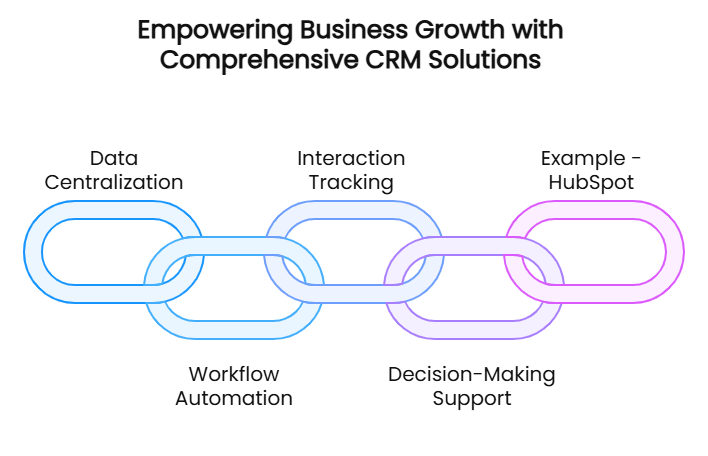
SEO & Competitive Intelligence
What It Is: A Customer Relationship Management (CRM) system is the backbone of your marketing, sales, and customer success efforts. It centralizes data, automates workflows, and tracks interactions to drive better decision-making.
Why You Need It: If your ideal customers can't find you, they won't buy from you. A strong SEO strategy ensures you show up ahead of competitors and capture high-intent traffic.
Example: Semrush
SEMrush provides keyword research, backlink analysis, and site audits to help you dominate search results. It also tracks competitor strategies, so you can outrank and outperform in your industry.
Related Read: Outsourced Marketing Services: Pros, Cons, & How to Hire the Right Team
User Behavior Analysis
What It Is: User behavior tools show how visitors interact with your site through heatmaps, session recordings, and click tracking.
Why You Need It: If your website isn't converting, you need to know why. These insights help identify friction points so you can optimize UX and increase conversions.
Example: HotJar
Hotjar provides visual insights into user behavior, showing where visitors scroll, click, and drop off, helping you refine page layouts, CTAs, and user flows for better engagement.
Related Read: Data-driven Growth Marketing: The Path to Success [With Examples]
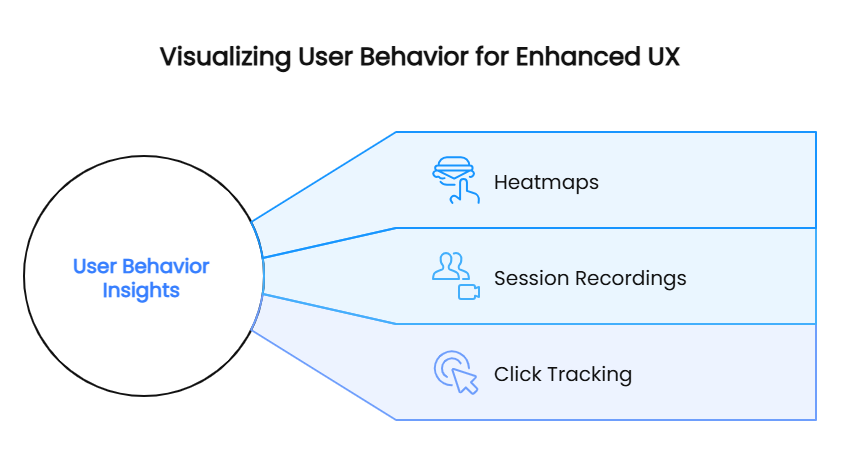
Team Collaboration & Workflow Management
What It Is: Project management tools keep marketing, sales, and product teams aligned by centralizing tasks, deadlines, and approvals.
Related Read: Product-Led Growth vs. Sales-Led Growth: Which is Best for You
Why You Need It: Misalignment slows execution. A structured workflow ensures teams stay organized, efficient, and focused on high-impact work.
Example: Monday.com / Asana
Both tools help streamline project management by automating task assignments, tracking progress, and ensuring nothing falls through the cracks—so teams can execute faster.
Related Read: How to Build a Marketing Team for Growth: Roles, Tools, & Hiring Tips
AI-Powered Content & Messaging
What It Is: AI-driven tools help generate, refine, and optimize marketing copy across ads, emails, blogs, and landing pages. The key is not to use generic tools like standard ChatGPT or Claude.ai, but to leverage trained, branded AI.
Why You Need It: Content marketing at scale requires speed and consistency. AI helps brainstorm ideas, test variations, and optimize messaging, helping you get to a top-tier result more quickly than manual efforts alone can achieve.
Example: Lean Labs AI Agents

We've developed a collection of tools designed to provide tailored results, recommendations, and copy based on your brand guidelines, goals, and voice. Check out our agent page to see our current free trials.
The Future of Growth Marketing
The only constant in marketing is change. Winning SaaS companies aren’t crushing their growth goals by sticking to their same old playbooks. They’re leveraging AI, automation, and data-driven strategies to scale smarter, convert faster, and retain better.
Here are some of the trends shaping the next era of growth marketing for brands like yours.
Related Read: How We Execute Lean Marketing to Reduce Waste and Accelerate Results
AI-Powered Personalization
- Dynamic content adaptation – AI customizes messaging based on user behavior
- Predictive lead scoring – Machine learning prioritizes high-intent prospects
- Automated optimization – Campaigns auto-adjust based on performance data
Why It Matters
Moving forward, personalization won’t be a “nice-to-have,” it’ll be table stakes.
Product-Led Growth (PLG) Integration
- Seamless product-marketing alignment – Marketing fuels adoption, not just MQLs
- In-product growth loops – Features that drive viral adoption (referrals, upgrades)
- Self-serve conversion paths – Trial-to-paid flows that reduce sales friction
Why It Matters
PLG-first SaaS companies grow faster with lower CAC and higher retention.
Revenue Operations (RevOps) Alignment
- Unified revenue teams – No more silos between sales, marketing, and customer success
- Integrated tech stacks – CRM, automation, and analytics work together seamlessly
- Clear attribution across touchpoints – Know exactly what’s driving revenue growth
Why It Matters
Growth isn’t just about new customer acquisition, it’s about optimizing every revenue-generating function in your organization.
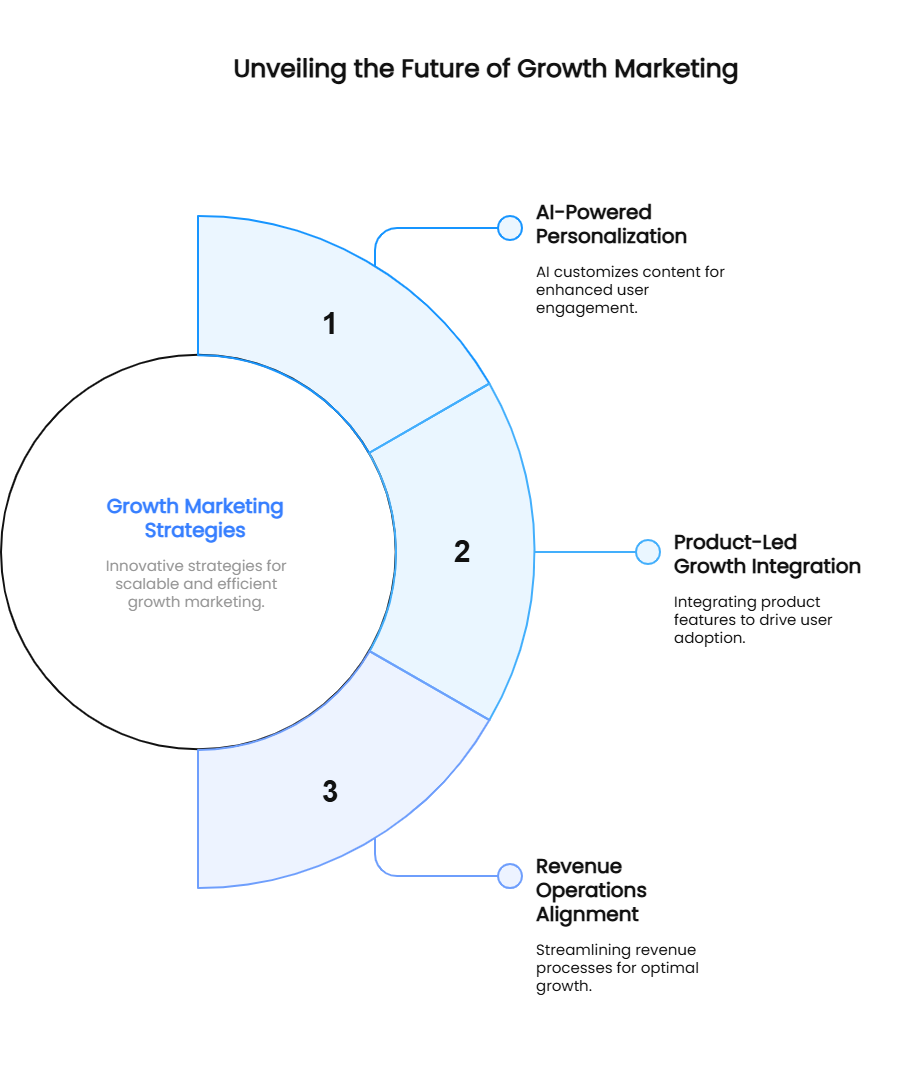
Next Steps
Implementing Your Growth Marketing Strategy
To get the most from your marketing efforts, you need a structured approach. Follow this simple, three-step process to eliminate the guesswork from your growth marketing implementation.
Step 1
Audit Your Current Growth System
- Identify your biggest growth bottlenecks - Where are leads dropping off?
- Benchmark against competitors - Are you ahead or falling behind?
- Map your tech stack gaps - Do you have the right tools to scale effectively?
You can’t fix what you don’t measure. You need to find the gaps in your funnel before you can begin to fill them.
Step 2
Build Your Growth Roadmap
- Define key metrics and targets - What KPIs matter most?
- Set clear quarterly objectives - Focus on measurable, revenue-driven goals
- Align team resources - Ensure marketing, sales, and product teams are in sync
Scaling without a plan leads to wasted spend and misaligned teams. Need help getting your plan in place? Schedule a free Growth Mapping Session with our Head of Growth today to get on the right track.
Step 3
Execute and Optimize
- Launch rapid testing cycles - Experiment with messaging, channels, and offers
- Monitor core metrics daily - Don’t wait until next quarter to spot a failing strategy
- Adjust based on data, not hunches - Let analytics drive your next move
Great SaaS companies test, learn, and adapt at speed. The best SaaS companies employ the help of an experienced growth partner to lead them through their growth marketing journey.
If you want to see exactly how we’d implement a growth marketing approach if we were in your shoes, book a Growth Mapping Session with us today.
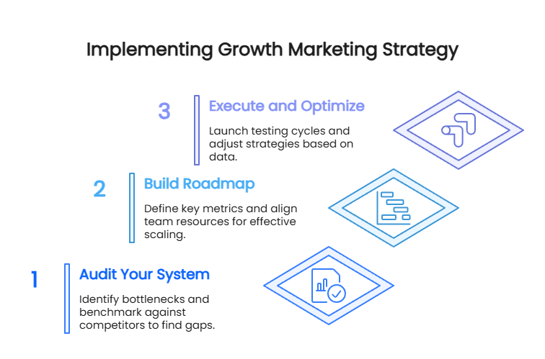
.png?width=765&height=430&name=7%20(1).png)
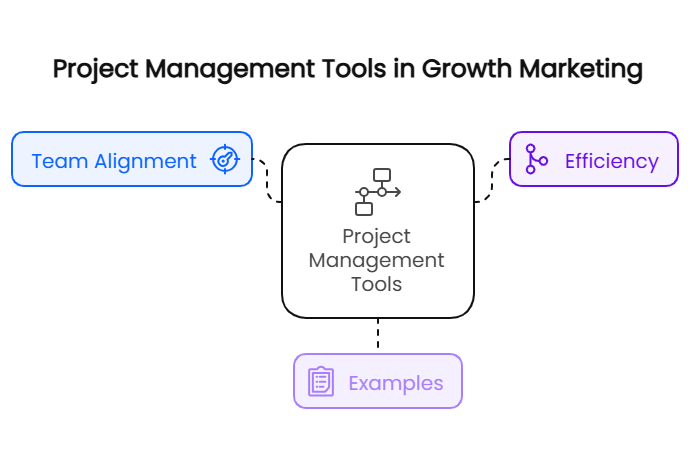


.png?width=500&height=500&name=hiring-ai-marketing-agency%20(2).png)

